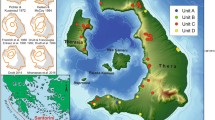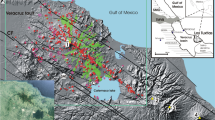Abstract
We present here a digital methodology aimed at identifying the morphometry of monogenic volcanic cones including edifice height, slope angle, and volume. We recognize more than 800 monogenic volcanic cones from the Harrat Ash Shaam volcanic province (HASV, northern Arabian Plate) to the north of the Arabian plate by using Landsat7 Enhanced Thematic Mapper plus and digital elevation models (Shuttle Radar Topography Mission, SRTM data). Our results show that the volcanic cones fall into six clusters, each one having a NW-SE orientation parallel to the Red Sea rifting. The density of the cones is most likely controlled by fissure distribution and a possible rotation in the HASV lithospheric block, rather than by the age of the volcanic activity. Interaction with crustal lithologies also plays a negligible role during magma migration. However, the morphology of the monogenic volcanic cones appears to be significantly modified by erosion processes, and both the height and slope of the various cones thus can be used to estimate their relative ages. From such morphological criteria, HASV monogenetic volcanoes in Jordan and Saudi Arabia are older than those in the Golan Heights and the Jabal Al Arab Mountain in Syria, thus, supporting the hypothesis of a northward migration of the recent explosive activity. Our new data, together with the available sediment thickness data, give rise to a new volcano-tectonic interpretation. We show that variations in the cumulative volume of monogenic volcanic cones in several zones of the study area can be related with the sediment thickness (basement depth), and therefore, we propose that the sediment thickness most likely affects the properties of magma before eruption. The reactivation of a deep previous fault perhaps also explains the higher volume of monogenic volcanic cones, focused along a well-defined alignment. This study, thus, gives insight into the relations between sediment thickness, the volcanism, and tectonics. Our results based on new digital treatment of remote sensing data are in overall good agreement with the volcano-tectonic evolution of HASV. This allows us to recommend this methodology as a potential tool to study volcanic cones of other inaccessible regions, either on Earth or other terrestrial planets.









Similar content being viewed by others
References
Abou-Deeb JM, Otaki MM, Tarling DH, Abdeldayem AL (1999) A palaeomagnetic study of Syrian volcanic rocks of Miocene to Holocene age. Geophys Int 38:17–26
Al Kwatli MA, Gillot PY (2010) A new method in volcano-morphology to investigate the tectonic constraints on the volcanism, case study of Harrat Al Sham volcanic field, Arabia plate: the interest of GIS and relational database. In: Proceedings of the 1st international Conference and Exhibition on Computing for Geospatial Research & Application (Washington, D.C., June 21–23, 2010). COM. Geo '10. ACM, New York, NY, 1–2, doi:10.1145/1823854.1823908
Al Kwatli MA, Gillot PY, Zeyen H, Hildenbrand A, Al Gharib I (2012a) Volcano-tectonic evolution of the northern part of the Arabian plate in the light of new K-Ar ages and remote sensing: Harrat Ash Shaam volcanic province (Syria). Tectonophysics 580:192–207
Al Kwatli MA, Gillot PY, Al Gharib I, Lefèvre JC (2012b) The integration of K-Ar geochronology and remote sensing: mapping volcanic rocks and constraining the timing of alteration processes (The Al-Lajat Plateau, Syria). Quat Int 251:22–30
Al Kwatli MA, Gillot PY, Lefèvre JC, Hildenbrand A, Kluska JM (2014) Magma genesis controlled by tectonic styles in the northern part of the Arabia plate during the Cenozoic. Spec Publ Geol Soc, Lond 392:61–91
Al Rawashdeh S, Saleh B, Hamzah M (2006) The use of remote sensing technology in geological investigation and mineral detection in El Azraq-Jordan. Cybergeo: Eur J Geogr 358. http://www.cybergeo.eu/index2856.html
Al-Amri AM, Fnais MS, Mogren S, Abdel-Rahman K, Al-Dabbagh M (2012) Geochronological dating and stratigraphic sequences of Harrat Lunayyir, NW Saudi Arabia. Int J Phys Sci 7(20):2791–2805
Al-Saad D, Sawaf T, Gebran A, Barazangi M, Best J, Chiamov T (1992) Crustal structure of central Syria, the intracontinental Palmyride mountain belt. Tectonophysics 207:345–358
Barazangi M, Seber D, Chaimov T, Best J, Litak R, Al-Saad D, Sawaf T (1993) Tectonic evolution of the northern Arabian plate in western Syria. In: Boschi E, Mantovani E, Morelli A (eds) Recent evolution and seismicity of the Mediterranean Region. Kluwer Academic Publishers, 117–140
Bender F (1974) Geology of Jordan. Bornträger, pp. 196, Berlin, Stuttgart
Brew, G., Barazangi, M., Al-Maleh, A. K.., Sawaf, T. 2001. Tectonic and geologic evolution of Syria. Geoarabia, 6:573–616.
Burrough PA, Mcdonnell RA (1998) Principles of geographical information systems. Oxford University Press, 1998
Camp VE, Roobol MJ (1989) The Arabian continental alkali basalt province: part I. Evolution of Harrat Rahat, Kingdom of Saudi Arabia. Geol Soc Am Bull 101:71–95
Chaimov T, Barazangi M, Al Saad D, Sawaf T, Gebran A (1990) Crustal shortening in the Palmyride fold belt, Syria, and implications for movement along the dead sea fault system. Tectonics 9:1369–1386
Chaimov T, Barazangi M, Al-Saad D, Sawaf T (1993) Seismic fabric and 3-D upper crustal structure of the southwestern intracontinental Palmyride fold belt, Syria. Am Assoc Pet Geol Bull 77:2032–2047
Cimarelli C, de Rita D (2006) Structural evolution of the Pleistocene Cimini trachytic volcanic complex (Central Italy). Bull Volcanol 68:538–548. doi:10.1007/s00445-005-0028-3
Cimarelli C, Di Traglia D, De Rita D, Gimeno Torrente D, Fernandez-Turiel JL (2013) Space–time evolution of monogenetic basaltic volcanism in the Garrotxa Volcanic Field, NE Iberian Peninsula. Bull Volcanol 75(11):1–18. doi:10.1007/s00445-013-0758-6
Coulié E, Quidelleur X, Gillot PY, Courtillot V, Lefèvre JC, Chiesa S (2003) Comparative K-Ar and Ar/Ar dating of Ethiopian and Yemenite Oligocene volcanism: Implications for timing and duration of the Ethiopian Traps. Earth Planet Sci Lett 206:477–492
Dóniz J, Romero C, Coello E, Guillén C, Sánchez N, García-Cacho L, García A (2008) Morphological and statistical characterisation of recent mafic volcanism on Tenerife (Canary Islands, Spain). J Volcanol Geotherm Res 173:185–195
Fry N (1979) Random point distribution and strain measurement in rocks. Tectonophysics 60:89–105
Garfunkel Z (1989) Tectonic setting of Phanerozoic magmatism in Israel. Isr J Earth Sci 38:51–74
Giannerini G, Campredon R, Feraud G, Abo Zakhem B (1988) Déformations intraplaques et volcanisme associé : exemple de la plaque arabique au Cénozoïque. Bull, Soc, Géol 6:937–947
Gomez F, Khawlie M, Tabet C, Darkal AN, Khair K, Barazangi M (2006) Late Cenozoic uplift along the northern dead sea transform in Lebanon and Syria. Earth Planet Sci Lett 241:913–931
Gomez F, Nemer T, Tabet C, Khawlie M, Meghraoui M, Barazangi M (2007) Strain partitioning of active transpression within the Lebanese restraining bend of the dead sea fault (Lebanon and SW Syria). Geol Soc Lond, Spec Publ 290:285–303. doi:10.1144/290.10
Gupta RP (2003) Remote sensing geology, 2nd edn. Springer, New York, p 655
Heimann A, Ron H (1993) Geometric changes of plate boundaries along part of the northern dead sea transform: geochronologic and paleomagnetic evidence. Tectonics 12:477–491
Ilani S, Harlavan Y, Tarawneh K, Rabba I, Weinberger R, Ibrahim K, Peltz S, Steinitz G (2001) New K-Ar ages of basalts from the Harrat Ash Shaam volcanic field in Jordan: implications for the span and duration of the upper-mantle upwelling beneath the western Arabian plate. Geology 29:171–174
Kazmin VG (2002) The late Paleozoic to Cenozoic intraplate deformation in North Arabia: a responce to plate boundary-forces. Stephan Mueller Spec Publ Ser 2:123–138
Khair K, Khawlie M, Haddad F, Barazangi M, Seber D, Chaimov T (1993) Bouguer gravity and crustal structure of the dead sea transform fault and adjacent mountain belts in Lebanon. Geology 21:739–742
Krienitz M-S, Haase KM, Mezger K, van den Bogaard P, Thiemann V, Shaikh-Mashail MA (2009) Tectonic events, continental intraplate volcanism, and mantle plume activity in northern Arabia: constraints from geochemistry and 40Ar/39Ar dating of Syrian lavas. Geochem, Geophys, Geosyst, 10. doi:10.1029/2008GC002254
Lahitte P, Gillot P-Y, Courtillot V, Kidane T, Bekele A (2003) New age constraints on the timing of volcanism in central Afar, in the presence of propagating rifts. J Geophys Res 108:2123. doi:10.1029/2001JB001689
Lustrino M, Sharkov E (2006) Neogene volcanic activity of western Syria and its relationship with Arabian plate kinematics. J Geodyn 42:115–139
Malabeh A, Kempe S (2012) Hypogene point karstification along wadi Sirhan Graben (Jordan). Acta Carsologica 41(1):35–45
Massol H, Jaupart C (1999) The generation of gas overpressure in volcanic eruptions. Earth Planet Sci Lett 166(57):70
Mcclusky S, Reilinger R, Mahmoud S, Ben Sari D, Taeleb A (2003) GPS constraints on Africa (Nubia) and Arabia plate motions. Geophys J Int 155:126–138
Mor D (1993) A time-table for the levant volcanic province, according to K-Ar dating in the Golan heights. J Afr Earth Sci 16:223–234
Mouty M, Delaloye M, Fontignie D, Piskin O, Wagner JJ (1992) The volcanic activity in Syria and Lebanon between Jurassic and actual. Schweiz Mineral Petrogr Mitt 72:91–105
Nasir S, Safarjalani A (2000) Lithospheric petrology beneath the northern part of the Arabian plate in Syria: evidence from xenoliths in basalts. J Afr Earth Sci 30:149–168
Osworth W, Huchon P, McClay K, Abbate E (2005) The Red Sea and Gulf of Aden Basins. In: Phanerozoic evolution of Africa - Special volume. J Afr Earth Sci, 43, 334–378
Quennell AM (1984) The Western Arabia rift system. In: Dixon JE, Robertson AHF (eds) The Geological evolution of the eastern Mediterranean. Geological Society of London, Special Publication 17:775–788
Sabins FF (1999) Remote sensing for mineral exploration. Ore Geol Rev 14:157–183
Sharkov EV, Chernyshev IV, Devyatkin EV, Dodonov AE, Ivanenko VV, Karpenko MI, Leonov YG, Novikov VM, Hanna S, Khatib K (1994) Geochronology of late Cenozoic basalts in western Syria. Petrology 2:385–394
Sharkov EV, Chernyshev IV, Devyatkin EV, Dodonov AE, Ivanenko VV, Karpenko MI, Lebedev VA, Novikov VM, Hanna S, Khatib K (1998) New data on the geochronology of upper Cenozoic plateau basalts from the northeastern periphery of the red sea rift area (northern Syria). Dokl Earth Sci 358:19–22
Shaw JE, Baker JA, Menzies MA, Thirlwall MF, Ibrahim KM (2003) Petrogenesis of the largest intraplate volcanic field on the Arabian plate (Jordan): a mixed lithosphere–asthenosphere source activated by lithospheric extension. J Petrol 44:1657–1679
Silverman BW (1986) Density estimation for statistics and data analysis. Chapman and Hall, New York
Sparks RSJ (2003) Dynamics of magma degassing. In Oppenheimer C, Pyle DM. 1093 Barclay, J. (eds), Volcanic degassing. Geol Soc Lond Spec Pub 213: 5–22
Walley C (1988) A braided strike-slip model for the northern continuation of the dead sea fault and its implications for Levantine tectonics. Tectonophysics 145:63–72
Weinstein Y (2000) Spatial and temporal geochemical variability in basin-related volcanism, northern Israel. J Afr Earth Sci 30:865–886
Weinstein Y, Navon O, Lang B (1994) Fractionation of Pleistocene alkali basalts from the northern Golan heights. Isr J Earth Sci 43:63–79
Weinstein Y, Navon O, Altherr R, Stein M (2006) The role of lithospheric mantle heterogeneity in the generation of Plio-Pleistocene alkali basaltic suites from NW Harrat Ash Shaam (Israel). J Petrol 47:1017–1050
Wilson JP, Gallant JC (2000) Terrain analysis: principles and applications. Wiley, 2000
Wood C (1980) Morphometric analysis of cinder cone degradation. J Volcanol Geotherm Res 8:137–160
Acknowledgments
The Cultural Service of the French embassy in Syria is thanked for supporting this work. IFPO (Institut Français du Proche-Orient) is thanked for the help and library facility. The author wishes to thank A. R. Basu (University of Texas Arlington), A. Peccerillo (Università degli Studi di Perugia), E. Barrier (Université Pierre et Marie Curie), F. Schmidt (Université Paris Sud), M. Devès, and S. Tait (Institut de Physique du Globe de Paris) for their indispensable comments. We would also like to thank S. Reynolds for carefull reading of the manuscript and suggestions regarding the English. We thank C. Cimarelli and an anonymous reviewer, and the Editor A. M. Al-Amri for their constructive comments, which helped to significantly improve the manuscript. This is LGMT contribution No 125.
Author information
Authors and Affiliations
Corresponding author
Rights and permissions
About this article
Cite this article
Al Kwatli, M.A., Gillot, P.Y., Lefèvre, J.C. et al. Morpho-structural analysis of Harrat Al Sham volcanic field Arabian plate (Syria, Jordan, and Saudi Arabia): methodology and application. Arab J Geosci 8, 6867–6880 (2015). https://doi.org/10.1007/s12517-014-1731-1
Received:
Accepted:
Published:
Issue Date:
DOI: https://doi.org/10.1007/s12517-014-1731-1




